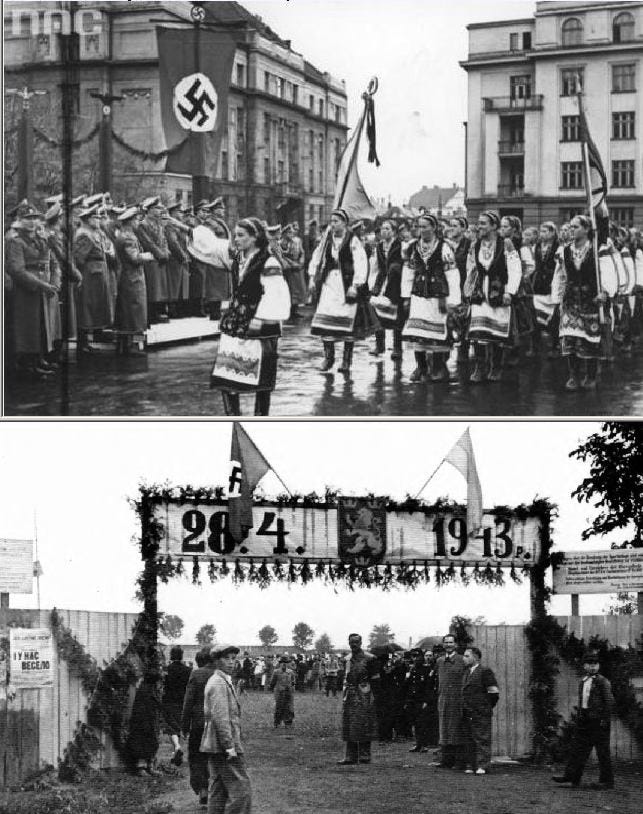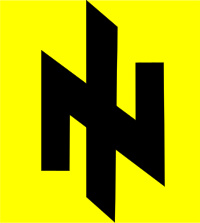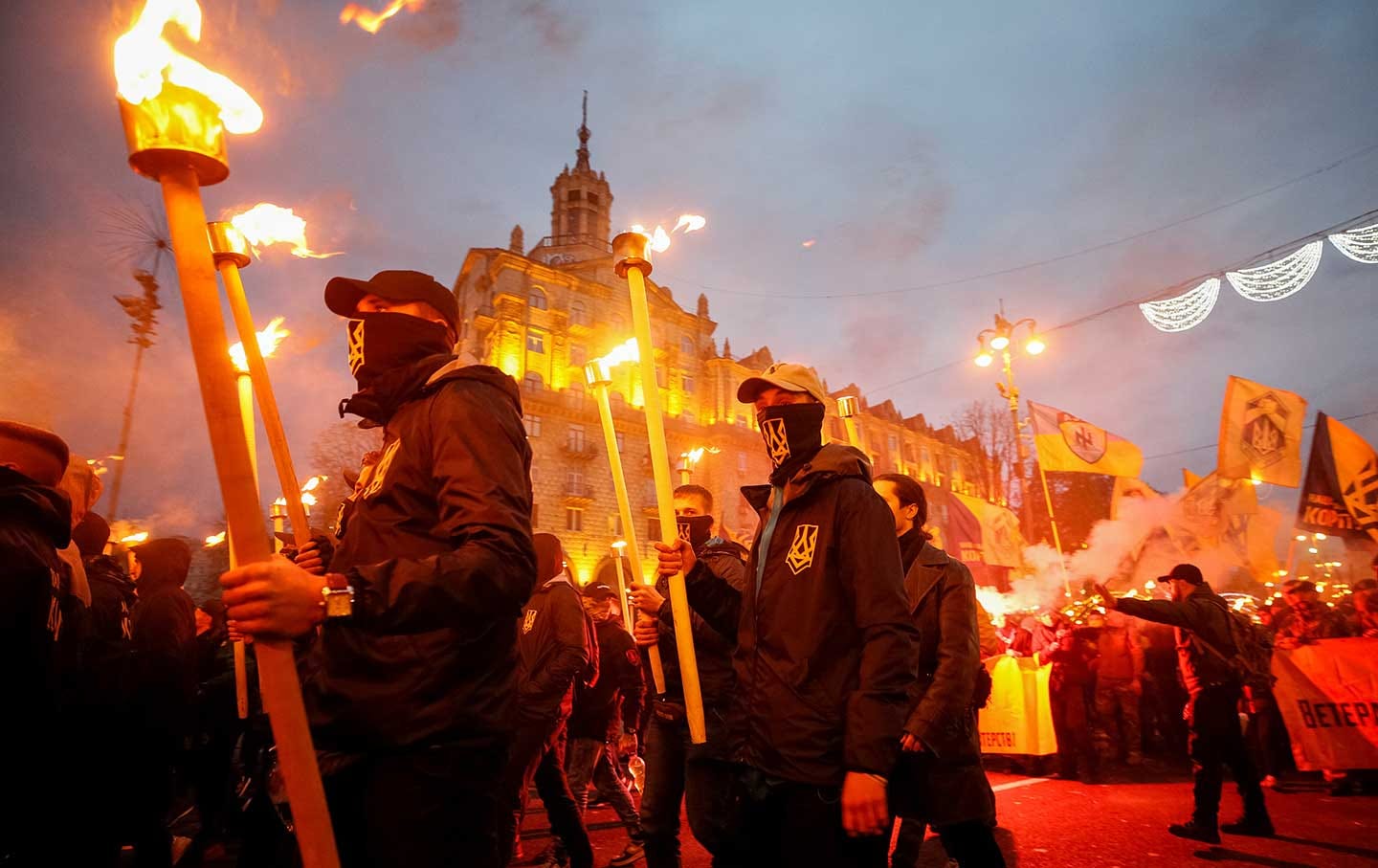
The case study "Ukraine" provides a useful prism through which to analyze the fate of the Russian world during the unipolar period 1989-2022. As is well known, on Christmas Day 1991, after a failed coup attempt in August and controversial referendums in March and in December, Yeltsin announced the disintegration of the Soviet Union and Soviet member states appeared on the world map, becoming, somewhat to the their own surprise, independent.

Just over thirty years later, on February 24, 2022, Russia announced a "special military operation for denazification and demilitarization" in Ukraine to protect the Donbass republics around Donetsk and Lugansk. The Anglo-American Empire responded with the de facto exclusion of Russia from the imperial structures and with a tsunami of hatred directed at the Russian state, government and people.
Here we will seek answers to the following questions: What led to this moment? Was it inevitable? What does "denazification" mean? Are the actions of the parties to the conflict morally justified? What awaits Russia, Ukraine, Europe, the Anglo-Americans and the world?
In order to be able to answer these questions, let us first try to understand exactly what Ukraine is and what its role was in the unipolar period.
The conclusions to which the facts lead me are in agreement with the positions of other analysts. I especially recommend the Ukraine that never existed (Украина, которой не было) (2015) by Andrey Vadjra (Андрей Ваджра) and The Secret History of Ukrainian Rus (Тайная история Украины-Руси) (2005) by Oles Buzina (Олесь Бузина) (1969-2015).
Vadjra (pseudonym) and Buzina are of particular interest, because they are both purebred “Ukrainians”. Buzina paid with his life for his views. “Unknown assailants” (i.e. nazis) murdered him in 2015, a year after the Maidan.
The constituent parts of the newly hatched Ukrainian state in the 20th century
Let us go back to 1991, when the Soviet Union split into its constituent republics, one of which was Ukraine. The key point here is that most of these "republics" had never existed as sovereign states, but simply represented the administrative regions created by the Communists after the 1917 revolution and reflected the Communists’ personal and ideological views.
Before 1917, European Russia consisted of 50 gubernias (provinces), roughly corresponding to the historical Russian cities, and one oblast (territory). Another administrative concept was the "regions", containing the governorates of border areas. In fact, for Slavs, it is obvious that "Ukraine" means something like "borderland".



The administrative region of Ukraine, which, by a whim of history, gained independence in 1991, consists of the following heterogeneous regions:
(1) Little Russia (Malorossiya): The core of the state around Kiev, composed of the Kiev, Chernigov, and Poltava provinces. This territory was core to the medieval Rus and joined the second Russian state in 1667. Half of the population uses Russian in everyday life.
(2) New Russia (Novorossiya): The steppes south of Kiev and north of the Crimea and between Bessarabia and Donbass, uninhabited for a while until the end of the 18th century because of Tatar raids and settled by all kinds of Eastern European peoples including similar numbers of Russians and Little Russians after 1794. Almost all population uses Russian in their everyday lives.
(3) Western Donbass on the southeastern border with Russia (Eastern Donbass is around Rostov in Russia): the area around Donetsk and Lugansk. The population has a pronounced national self-awareness and speaks Russian at home. Many also have Russian self-awareness.
(4) The Kharkov region on the northeastern border with Russia. The capital Kharkov was founded around 1654. The population uses Russian in everyday life. A significant part of them have a Russian self-awareness.
(5) Galicia-Volynia on the border with Poland. Part of Medieval Russia. Later, part of the Polish-Lithuanian Kingdom between 1359 and 1772. After the partition of Poland, Galicia passed into the Habsburg Empire. After the First World War, it passed into the Second Polish State. The USSR captured Galicia in 1939 and annexed it to the Ukrainian SSR. Galicia-Volynia is the part of Ukraine where the Ukrainian language dominates everyday life.
(6) The Crimean Peninsula: Settled after the conquest of the Tatar nomads in the late 18th century. Moved by Khrushchev from the Russian SSR to the Ukrainian SSR only in 1954. The population has an almost entirely Russian identity.
(7) Eastern Bessarabia (nowadays Western Bessarabia goes by Moldova): The lands southwest of Odessa were settled after 1794 by various peoples including nearby Bulgarians and Romanians. Near the Russian enclave of Transnistria.
Of the seven cities awarded until 1965 with the honorary title of "Hero City" for "mass heroism" during the war, three are located in Ukraine: Kiev, Odessa and Sevastopol; with Odessa and Sevastopol receiving the title as early as 1945. Kerch, on the eastern edge of Crimea, was declared a Hero City in 1973. Huge battles also raged around Kharkov, which changed hands four times between October 1941 and August 1943.

Poltava, where the Swedes were defeated in 1709, and again Sevastopol, besieged by Great Britain and France in 1854, are also of fundamental and important importance in Russian history.
One of the leaders of the Russian literary canon, Gogol, was born in the Poltava Region. Regarding his self-awareness, he wrote the following in 1844 in a letter to Alexander Smirnov:
To this I will tell you that I myself do not know what kind of soul I have, Hohol ["Ukrainian"] or Russian. I only know that in no way would I give an advantage either to a Little Russian over a Russian, or a Russian over a Little Russian. Both natures are very generously endowed by God, and as if on purpose each of them separately contains in itself what is not in the other - a clear sign that they should complement each other.
Nikita Khrushchev (1894-1971), who ruled the USSR after Stalin between 1953 and 1964, was born between Kursk and Kharkov and spent his childhood in Donetsk. His second wife, Nina, was Ukrainian. He liked to wear clothes from the Ukrainian region. He rose to Soviet power as head of the Ukrainian SSR. To this day, there are disputes whether he is Ukrainian or Russian. This shows that it is often difficult to distinguish between the two peoples, and that Khrushchev took much from both consciousnesses, in so far as they differ.
From the history and linguistic-ethnic composition of Ukraine, it is clear that the Ukrainian Soviet Socialist Republic, established in 1919 and granted independence in 1991, is a strange heterogeneous entity that for a thousand years has been an important, valued and protected part of the Russian world and its two historical states.
Russians have shed rivers of blood in defense of the lands now called “Ukraine” for a millennium. One cannot overstate this elementary historical fact.
Arising from the same roots, Russian and Ukrainian speak similar, brotherly and mutually intelligible languages. After all, to this day in the major European countries - Germany, France, Spain and Italy - there is an official literary national version of the language, which differs from dialects used in everyday life in certain border areas. Examples are: In Spain, Catalan and Basque; the Meridional dialect spoken in southern France; the Bavarian dialect in Germany and the Sicilian dialect in southern Italy. The status of Ukrainian - or Little Russian - in the Russian Empire was similar - a regional dialect of the main literary language.
Separately, the territory of Ukraine is large and diverse. There is a difference between the "Ukrainian" dialect spoken in Lvov and the one spoken in, for example, Chernigov or Kharkov ("surzhyk"). The first has many words borrowed from Polish and German, and the second is closer to Russian. Which version of the language will be declared literary is generally up to the government. In The Ukraine That Never Was, Andrey Vadjra presents the well-researched thesis that Ukrainian is exactly a version of Galician deliberately filled with Polish words to be further away from Russian.
The northern lands of the Ukrainian state have been a deeply integrated part of the Russian world for more than three centuries; and the southern ones for more than two. Little Russia and New Russia were part of the Russian state long before Italy and Germany were formed in 1871 from the hundreds of sovereign territories in central Europe and along the Apennines. Little Russia became part of the Russian state half a century before Scotland and England created the United Kingdom (Great Britain) in 1707, and the Russian Empire settled New Russia and the Crimea decades before the US captured Florida from the Spanish (1821) and California from Mexico (1847).
Genetically, the three Russian peoples - Ukrainian (Little Russian), Belarusian (White Russian) and (Vanilla) Russian are practically the same, with the predominant haplogroup R1a.
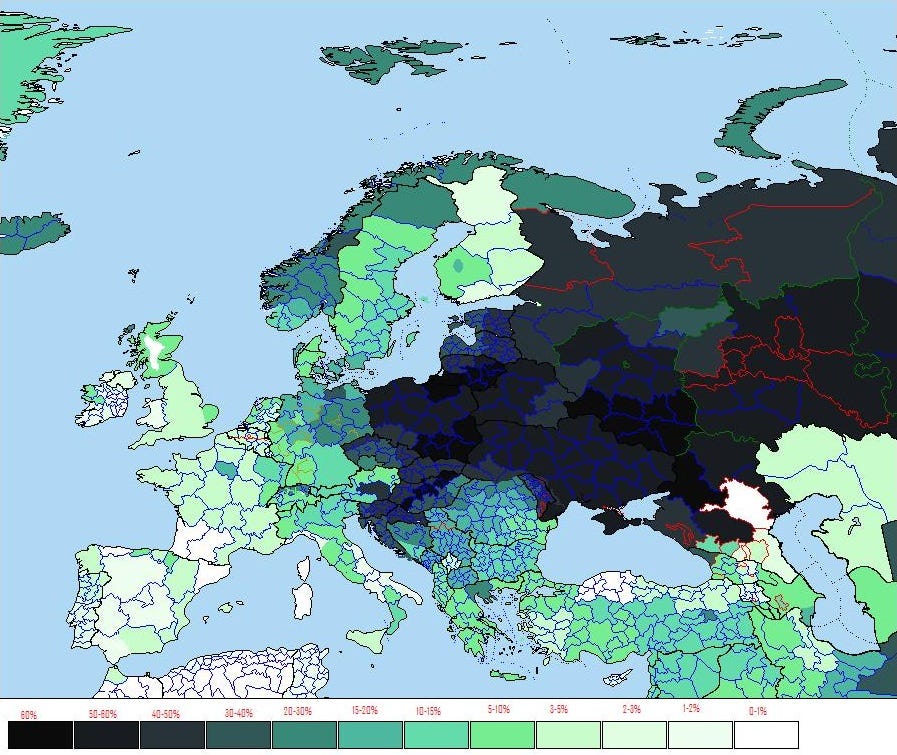
So it is safe to say that if the events of 1991 had turned out a little differently, Ukraine - Little Russia and New Russia - would have been part of Russia (along with Belarus), just as Provence is part of of France, Bavaria is part of Germany, Sicily is part of Italy, Wales is part of the United Kingdom, California is part of the USA, etc.
As far as they can be said to be something different and not just variations of one essence, by and large, Russians and Ukrainians (and Belarusians) have one history, one blood, similar languages stemming from one language, one faith, and until 30 years ago, one country.
This is the core tragedy of the collapse of the Soviet Union. Separating non-Slavic and non-Orthodox peoples from the Soviet sphere of influence is one thing. Let Poland and Hungary, and maybe even the Baltic states (where many Russians live) go their separate ways. But the division of the Russian world into three independent states (if we do not count the Central Asian territories - Kazakhstan, Kyrgyzstan, Turkmenistan, etc.), two of them with a non-existent state tradition and highly vulnerable to manipulation, is a historical mistake and the main factor that led to 24 February 2022.
As for the manipulation, it was carried out in the last 30 years by the Anglo-American Empire in a particularly cynical way.
Galicia - the rotten apple of neo-Nazism that poisoned Ukraine
Wisely or not, Ukraine gained independence (“незалежність”) in 1991. Its rulers and residents faced the daunting task of building a prosperous and stable state out of the heterogeneous territory (the jewel of the Russian Empire and the USSR - a “Second France”) in which they found themselves.
As we saw above, over a fifth of the population of “Ukraine” saw itself as Russian. Apart from that, even the Ukrainian inhabitants of Crimea, Donbass, Novorossiya and Kharkov mainly used Russian in their daily lives, in addition to at least half of the population in Little Russia. Only in western Ukraine - Galicia and Volynia - did Ukrainian dominate.
Language, as a carrier of culture, is of fundamental importance in the formation of national and ethnic self-awareness. What are Ukrainians who speak Russian? Are they a separate ethnic group, or simply the inhabitants of a separate region of the country, like Texans and Californians? And even Ukrainians speaking Ukrainian - is Ukrainian more different from Russian than Cockney English from Minnesotan English?
For this reason, with the goal of creating a Ukrainian self-consciousness strictly distinct from the Russian, since 1991 and in the first half of the 20th century, several groups have sought the destruction of the Russian language in Ukraine, a goal that inevitably has led to civil resistance and deterioration of relations between Kiev and Moscow. These groups were: the Bolsheviks in the 1920s for ideological and other reasons; The Anglo-American Empire and before that Poland and Austria-Hungary to the detriment of Russia; politicians and oligarchs benefiting from Ukrainian sovereignty; and the highly chauvinistic and anti-Russian western provinces of Galicia and Volynia.
As mentioned above, Galicia was the (Greek-)Catholic province that returned to the Russian world only after the First World War and spent centuries in Poland and the Austrian Empire.
Galicia’s relationship with the Russia is complicated. To some extent, Galician feelings and views are understandable and justified. It can be said that, after centuries of drift, Galicia is part of the Western Catholic-Protestant world - and therefore its place is not in the Russian Orthodox world. But the powerful expression of Nazism on the part of the Galicians during the war and since 1991 cannot be justified.
The nationalist movements of the 19th century reached a crescendo in the 1930s. Galicians turn out to be one of the special and indicative examples of the phenomenon. Alienated heirs of the Ancient Rus and the medieval Principality of Galicia-Volynia, with considerable help from Austria-Hungary and the Polish nobility (as described in the recommended literature), in the early 20th century Galicians developed a sharp "Ukrainian" national self-awareness with Galician characteristics, which remained unsatisfied with the redrawing of European borders in the Treaty of Versailles. Ukrainization, which the Bolsheviks (most of them non-Russian) carried out in the 1920s with the aim (among other things) of creating the illusion of the Soviet state as the bearer of the world revolution, further sharpened this self-awareness, not shared by the other originally Russian regions of the Ukrainian SSR - Little Russia, New Russia and Crimea. Thus, in the 1930s, Galicians wanted their own state independent of Russia and Poland and hoped that Germany would help them.
The Galician Nazi party was called the Organization of Ukrainian Nationalists (OUN) and was founded in 1929 in Vienna. Its famous members were: Andrei Melnik, Stepan Bandera, Yaroslav Stetsko, Roman Shuhevich, Nikola Lebed (convicted for participation in the murder of a Polish minister in 1934) and others. The professed doctrines of the organization were frankly Nazi - the enslavement and expulsion of all who failed to meet the OUN's definition of a Ukrainian; and the quest for "glory, power and space" for the future great Galician Ukrainian state.
The OUN welcomed the Third Reich's victory over Poland in 1939 in the hope that it would get what it wanted. But Galicia went to the Soviet Union. After the Germans captured Lvov in the early days of Operation Barbarossa, on June 30, 1941, the OUN declared the Ukrainian State.

Then they set about helping the Germans to clear Galician Ukraine of unwanted people - Poles, Russians and Jews (many of whom at that time lived in these lands). The OUN slaughtered tens of thousands of Poles in Galicia-Volynia with particular sadism. In 2016, the Polish parliament declared the massacres a genocide. The OUN also helped the Germans in the notorious massacres of Jews in the area.
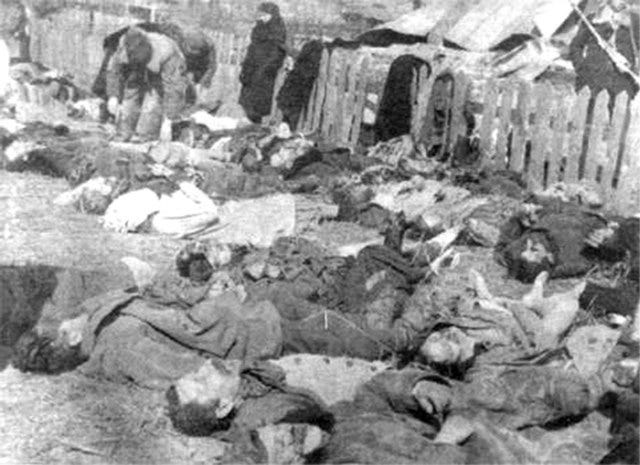
In 1943, the Germans agreed to create an SS division of volunteers from Galicia. In 1944, the division also became part of the Waffen SS.
Many UAN leaders and members surrendered to the Allies at the end of the war. Deciding that these hate-filled individuals might be useful in the future, Washington and London gave the Galician Nazis shelter in the West. The recruitment of OUN Nazis by Western intelligence services is described in the book MI6: Inside the Covert World of Her Majesty's Secret Intelligence Service (2002) by Stephen Dorril. Melnik lived in Canada and West Germany and died of old age in Luxembourg in 1964. Stretsko also lived to old age and passed away in Munich in 1986. Bandera worked for West German intelligence in Munich until his death, likely by assassination, in 1958. Nikola Lebed lived for many years in New York and died in Pittsburgh in 1998.
Despite the purges of Nazi sympathizers carried out in Galicia-Volynia by Poland and the USSR after the war, with the help of Western services, the ideas and even the structure of the OUN survived and continued to exist after the war.
When the new era came after 1991, new successor parties of the OUN were created in Ukraine. The Svoboda (“Freedom”) Party was founded in Lvov in 1991 with the formal name "Social Nationalist Party of Ukraine". In addition to its openly Nazi name, the party is distinguished by purely Nazi symbolism and philosophy.
Oleg Tyagnibok (1968-) became the head of the party after 2004. He participated in several Ukrainian parliaments. After the 2014 coup, Svoboda was given three gubernatorial positions (Poltava, Rovno, Ternopol) and three ministerial positions in the new cabinet.
The "Right Sector" emerged around the Maidan protests in November 2013. One of the founding groups of the Right Sector is "Trident" (one of the symbols of UAN), led by Dmytro Yarosh (1971-). The Right Sector is an openly Nazi organization in the style of the "brown shirts" - i.e. radicalized lumpens used to establish control of the streets by threatening physical violence. In April 2015, Yarosh was appointed as an "advisor" to the Ukrainian military forces.
The reason for the appointment can be traced back to the Azov Regiment, a paramilitary group of outspoken Nazis from Ukraine and around the world organized in May 2014 to quell the uprisings that arose in response to anti-Russian discrimination following the Maidan coup. People like Yarosh acted as intermediaries between the neo-Nazi regiments and the official authorities. Between 2014 and 2022, in the Donbass war, the Azov Regiment distinguished itself with various war crimes.
There are many more examples of the pronounced neo-Nazi presence in Ukraine before and especially after the Maidan coup. The reader can easily find details with a little searching. Also worth watching are two documentaries from 2016. One is in French from Canal+ and is called Ukraine: Les masques de la révolution.
The other is called Ukraine on Fire (2016), and was produced by the legendary two-time Oscar-winning American director Oliver Stone. These are two independent films made in the West and showing the Ukrainian Nazis in all their glory.
(Both documentaries are also available on Bitchute.)
The venerable American magazine The Nation profiled the Ukrainian Nazis in an article dated February 22, 2019 titled Neo-Nazis and the Far Right Are On the March in Ukraine with the subtitle Five years after the Maidan uprising, anti-Semitism and fascist-inflected ultranationalism are rampant.
Five years ago, Ukraine’s Maidan uprising ousted President Viktor Yanukovych, to the cheers and support of the West. Politicians and analysts in the United States and Europe not only celebrated the uprising as a triumph of democracy, but denied reports of Maidan’s ultranationalism, smearing those who warned about the dark side of the uprising as Moscow puppets and useful idiots. Freedom was on the march in Ukraine.
Today, increasing reports of far-right violence, ultranationalism, and erosion of basic freedoms are giving the lie to the West’s initial euphoria. There are neo-Nazi pogroms against the Roma, rampant attacks on feminists and LGBT groups, book bans, and state-sponsored glorification of Nazi collaborators.
These stories of Ukraine’s dark nationalism aren’t coming out of Moscow; they’re being filed by Western media, including US-funded Radio Free Europe (RFE); Jewish organizations such as the World Jewish Congress and the Simon Wiesenthal Center; and watchdogs like Amnesty International, Human Rights Watch, and Freedom House, which issued a joint report warning that Kiev is losing the monopoly on the use of force in the country as far-right gangs operate with impunity.
Five years after Maidan, the beacon of democracy is looking more like a torchlight march.
And here is a Reuters article from March 18, 2018:
As Ukraine’s struggle against Russia and its proxies continues, Kiev must also contend with a growing problem behind the front lines: far-right vigilantes who are willing to use intimidation and even violence to advance their agendas, and who often do so with the tacit approval of law enforcement agencies.
A January 28 demonstration, in Kiev, by 600 members of the so-called “National Militia,” a newly-formed ultranationalist group that vows “to use force to establish order,” illustrates this threat. While the group’s Kiev launch was peaceful, National Militia members in balaclavas stormed a city council meeting in the central Ukrainian town of Cherkasy the following day, skirmishing with deputies and forcing them to pass a new budget.
Many of the National Militia's members come from the Azov movement, one of the 30-odd privately-funded “volunteer battalions” that, in the early days of the war, helped the regular army to defend Ukrainian territory against Russia's separatist proxies. Although Azov uses Nazi-era symbolism and recruits neo-Nazis into its ranks, a recent article in Foreign Affairs downplayed any risks the group might pose, pointing out that, like other volunteer militias, Azov has been “reined in” through its integration into Ukraine’s armed forces. While it’s true that private militias no longer rule the battlefront, it’s the home front that Kiev needs to worry about now.
But can’t there be good Nazis? Our Nazis? Brave, heroic, beautiful Nazis?
No. The nature of Nazism leads to the aggravation of relations with the neighbors of the Nazi state. This leads to a war that ends with the destruction of the Nazi state. This process is due to the psychology of Nazism, the ideological foundations of which are the blind faith in the greatness and special destiny of the given superhuman people (ubermensch), limited in the past by vile subhumans (untermensch, Tatar Muscovites, etc.), whose destruction is thus justified.
Such beliefs inevitably breed anger, envy, hatred and arrogance in the infected people. Hatred and anger lead to unbridled aggression and war to destroy the subhumans. But because it lacks a realistic assessment of itself (the “superhuman”) and the enemy (the “subhuman”), the Nazi state inevitably attracts more and stronger enemies than it can defeat. An inevitable collapse follows.
Blind faith in the greatness of the “chosen/special” people leads to suicidal nihilism. First, because the true believers expect a miracle even as the subhumans surround their capital. And second, because if the chosen special nation loses the war, then it is not great and special and hence does not deserve to exist. The fate of Germany and Japan in 1945 and Ukraine in 2022 are examples of the self-destruction of the Nazi state and the damage wrought by its rampage.
As for the Maidan revolution of November 2013 - February 2014, it was a classic example of a color revolution and follows the entire repertoire of techniques developed by the British over the centuries and perfected by the CIA after WWII. William Engdahl offered a detailed overview of color coups in the 2011 book Full Spectrum Dominance.
The 2014 Maidan was actually the second color revolution in Ukraine after the first one in 2004 turned out to be impermanent. Well-known and shown in Stone's film is the recorded conversation between the US State Department representative for Ukraine, Victoria Nuland (the lady with the cookies) and the US ambassador to Ukraine, Jeffrey Payet, in which the two discuss who to appoint as president after the coup d'état in Kiev.

Nuland: What do you think?
Payet: I think we're in play. The Klitschko [Vitaly Klitschko, one of three main opposition leaders] piece is obviously the complicated electron here. Especially the announcement of him as deputy prime minister and you've seen some of my notes on the troubles in the marriage right now so we're trying to get a read really fast on where he is on this stuff. But I think your argument to him, which you'll need to make, I think that's the next phone call you want to set up, is exactly the one you made to Yats [Arseniy Yatseniuk, another opposition leader]. And I'm glad you sort of put him on the spot on where he fits in this scenario. And I'm very glad that he said what he said in response.
Nuland: I don't think Klitsch should go into the government. I don't think it's necessary, I don't think it's a good idea.
The 2008 presidential candidate Senator John McCain also came to tell everyone whose side Washington is on. The involvement of neo-Nazi groups in the February 2014 coup and the bloodshed caused by gunfire from buildings they controlled has been well documented.



Repression against the Russian ethnic group and the Russian language in Ukraine, prepared and desired since 1991 by the parties with a center of gravity in Galicia, immediately followed the Maidan coup. The governments of Yatsenyuk, Poroshenko, and Zelensky pushed laws clearly aimed at eliminating the Russian language in Ukraine and turning Ukraine into an Anti-Russia. Bandera and his comrades from the Nazi OUN were declared national heroes. In 2019, Kiev declared the OUN partisans - specifically the Banderists - as veterans, who are entitled to the same pensions as those who served in the Red Army during the Great Patriotic War.
The Russian-speaking and quasi-Russian regions of Ukraine reacted to the 2014 coup with natural resentment. With a nod from the Kremlin, Crimea held a referendum and joined Russia. Kiev reacted and organized repressions in Odessa and Kharkov. In Donbass, in the cities of Donetsk and Lugansk, citizens took up arms in self-defense. In the summer of 2014, a civil war erupted, culminating with the events of February 22-24, 2022. Infamous in Russia and Ukraine and virtually unknown in the West, this war claimed 15,000 lives and created a million refugees. A book recently translated into English describing the events of the beginning of the war is 85 Days in Slavyansk (85 дней Славянска) (2018) by A. Zhuchkovsky.
Residents of the Donetsk and Luhansk regions have been living in bomb shelters for years. Attempts to resolve the conflict peacefully through the two Minsk agreements failed, because, as they admitted recently, the Ukraine and Berlin signed the agreements in bad faith. The futility of negotiations caused by the lack of connection with reality on the part of Kiev was epitomized by the decree on the return of Crimea signed by Zelensky in February 2021.
The blatantly anti-Russian intentions of the post-coup Galicified and Nazified Ukraine gradually led toward the official or semi-official acceptance of Ukraine into NATO, meaning missiles aimed at Moscow in territories defended by Russia from European invaders for centuries. In February 2022, the Ukrainian President Zelensky hinted that the idea of Ukraine acquiring nuclear weapons was being discussed.
These are the events that led to February 24, 2022 and the war between Russia and Ukraine. Was the Russian invasion justified and just? Here we should recall Kant's "categorical imperative": moral laws must be universal. I.e. the same rules apply to the Empire and to Russia. Anything else is hypocrisy.
If the US was within its rights to attack Iraq in 2003 because it had reasonable suspicions that Iraq might develop and use weapons of mass destruction, then Russia was within its rights to attack Ukraine in 2022 if there were reasonable suspicions that the openly hostile Kiev regime could develop and use nuclear or biological weapons of mass destruction against Russia. A big difference here is that the Russians found bio-labs in Ukraine and the Americans found nothing in Iraq.
If the fate of Ukrainian civilians is a tragedy and a crime, the same applies for the residents of Donbass, Syria, Libya, Iraq, Afghanistan, Yemen and other other countries attacked by Washington or Washington's allies and satellites. It is indolence and hypocrisy to shed crocodile tears for some and ignore others as if they do not exist.
If Nazism is a particularly vile evil, then its presence in Ukraine calls for decisive action and condemns the government of Ukraine and the supporters of this evil in Ukraine and in the West. Europe is particularly guilty given the events of the period 1939-1945.
If after 1991, the Yugoslav republics (including Kosovo) had the right to unilaterally declare independence and ask for external support because of repression, the same applies to Crimea, Donbass, etc.
After 1812 and 1941 (and even the 1990s), could Russia seriously believe that a united Western empire would not attack and destroy it if given the slightest chance, possibly leading to a nuclear war with billions of casualties? What else is Ukraine but a Frankenstein designed to fight Russia? A golem conjured by Washington to cause maximum bloodshed? A kamikaze headed for the carrier?









